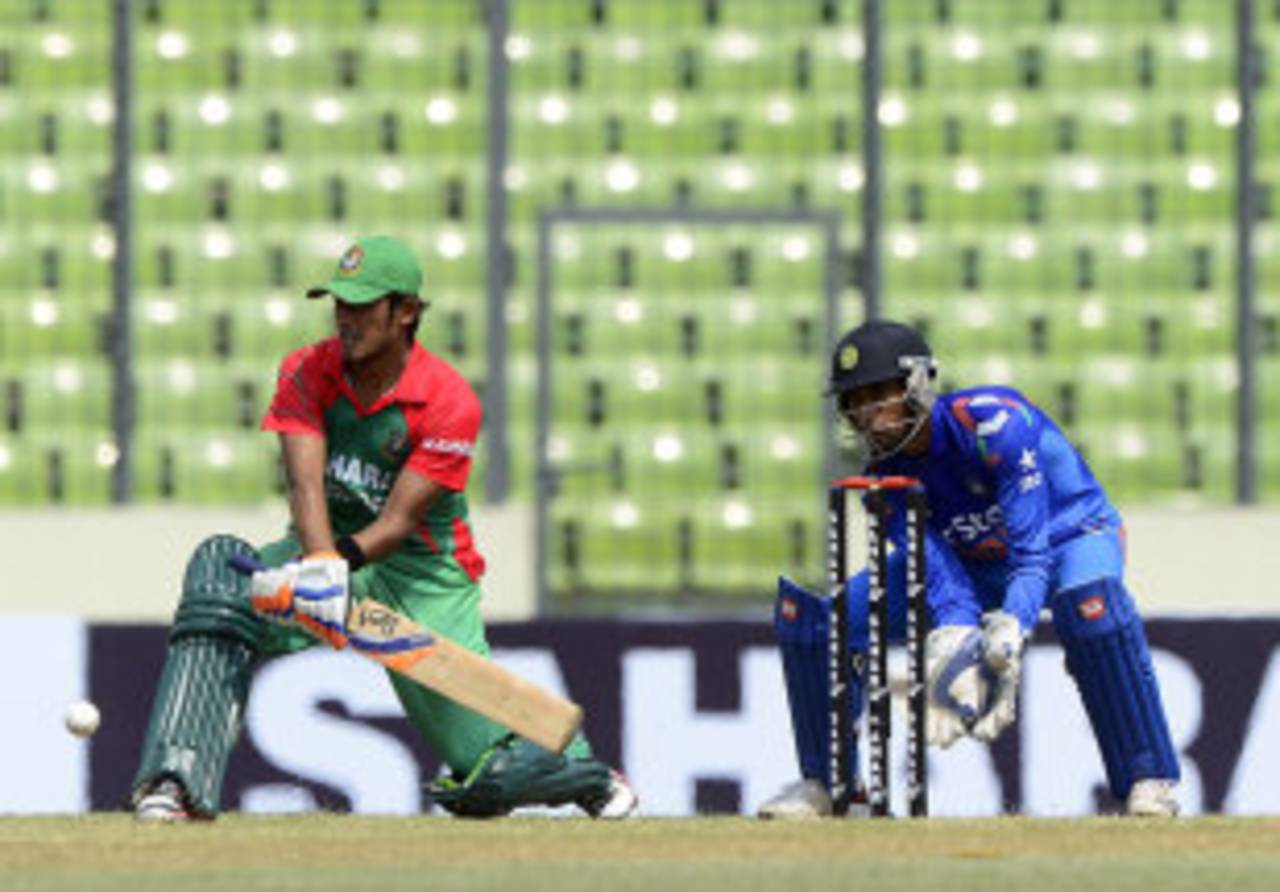Bangladesh's 272 for 9 can be called a decent total on a slow pitch, but the absence of two key factors held them back from setting India an even more challenging target. None of the four set batsmen -
Anamul Haque, Mushfiqur Rahim, Shakib Al Hasan and Mahmudullah - kicked on to stretch their innings to a big one, which didn't allow partnerships to grow. The innings also put a spotlight on Anamul Haque, who hardly rotated the strike.
Anamul was dismissed for 44, trying to force the pace. His shot was aimed at hauling his innings out of a sluggish phase but it did not benefit the team at the stage. Anamul struck seven boundaries in his innings, but picked up only 14 singles in his 60-ball innings. Towards the end of his innings, he did pick up at least one single from the 18th to 22nd overs. However, between the fourth and the ninth over he took just one single, while scoring five boundaries. He failed to pick up the pace later on and, apart from his sluggish single-picking, ran two runs just once.
Mushfiqur and Shakib made fifties, while Anamul and Mahmudullah were both out after scoring 40s. Mushfiqur and Shakib were out trying to force the pace in the 31st and 42nd overs while Mahmudullah was outfoxed by Amit Mishra in the 45th over. Interestingly, all three batsmen fell at stages when the innings required a push, but that need was not immediate. Mushfiqur and Shakib could have waited before playing the shots that got them out, but they were batting at their usual high tempo.
During this Bangladesh innings, 48.2% of the 58 deliveries Shakib faced resulted in singles; Mushfiqur had 39.6% while 29.5% of Mahmudullah's 44 deliveries yielded singles. Anamul had a singles percentage (per total balls) of 23.3% in this list, despite being the third-highest scorer.
Singles scored by select batsmen during the 1st ODI between India and Bangladesh
| Batsman |
Balls |
Singles |
Score |
Singles % (per total balls) |
| Anamul Haque |
60 |
14 |
44 |
23.33 |
| Mushfiqur Rahim |
63 |
25 |
59 |
39.68 |
| Shakib Al Hasan |
58 |
28 |
52 |
48.28 |
| Mahmudullah |
44 |
13 |
41 |
29.55 |
In the last five years, among the four openers who have played more than 10 ODIs, Anamul is also at the bottom of the list when it comes to taking singles - at 25.4% behind Junaid Siddique (31.7%), Tamim Iqbal (29.4%) and Imrul Kayes (25.6%).
Singles scored by Bangladesh openers from the last five years (entire innings)
| Batsman |
Balls |
Singles |
Singles % (per total balls) |
| Tamim Iqbal |
2746 |
808 |
29.42 |
| Imrul Kayes |
2016 |
517 |
25.64 |
| Junaid Siddique |
1255 |
399 |
31.79 |
| Anamul Haque |
819 |
208 |
25.40 |
Since openers bat in the first 10 overs of field restrictions, an argument can be made that it is harder to pick singles when the field is up. In this case, Anamul is the second lowest, utilising 15.15% of deliveries in singles while Tamim and Junaid have a better percentage. Imrul Kayes is the lowest in this phase of the innings, taking singles off only 14.3% of deliveries faced.
Singles scored by Bangladesh openers from the last five years (first 10 overs)
| Batsman |
Balls |
Singles |
Singles % (per total balls) |
| Tamim Iqbal |
1478 |
301 |
20.37 |
| Imrul Kayes |
984 |
141 |
14.33 |
| Junaid Siddique |
537 |
99 |
18.44 |
| Anamul Haque |
363 |
55 |
15.15 |
After the first Powerplay, however, Anamul bats more freely, scoring singles off 33.5% of deliveries. He has developed into a stable opening batsman after losing his place late last year and has been the team's second most successful batsman in 2014, but his strike rate and this inability to rotate the strike need to be addressed.
On Sunday, he became Parvez Rasool's first ODI wicket when he holed out to deep midwicket, a dismissal similar to the one
against Pakistan in the Asia Cup two months ago. It is possibly his get-out shot, but against India in Mirpur, Anamul also tried and found some success playing the reverse-sweep.
While the untimely dismissals of Mushfiqur, Shakib and Mahmudullah affected the team's score, Anamul's own sluggishness meant that Bangladesh's overall run-rate was 3.95 when he was out. One might say Tamim's early dismissal and Mominul Haque's lacklustre effort also affected the way Anamul paced his innings, but picking up singles is a matter of habit, and one that usually helps batsmen get bigger scores. After Anamul's wicket, the Bangladesh innings flourished at times, but 80 runs in the last overs was never going to be enough, particularly when they were well placed at 192 for 4 in 40 overs.
Bigger individual innings will certainly help Bangladesh but these minor changes can also contribute to a better performance in the rest of the series.
Mohammad Isam is ESPNcricinfo's Bangladesh correspondent. @isam84
